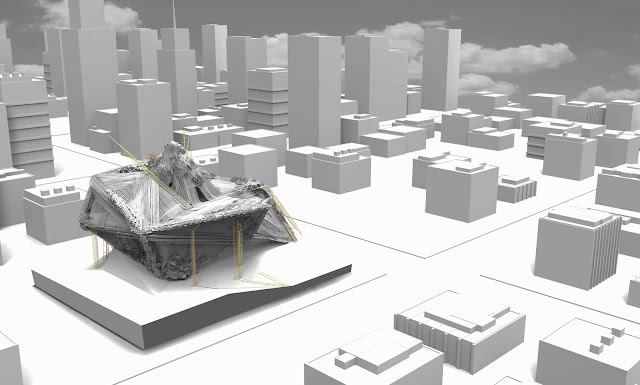Texas A&M University. Department of Architecture. T4T LAB Spring 2015.
ALIEN, MESSY, DISCRETE
Invited Professor: Gilles Retsin
With Gabriel Esquivel
Team: Collin Stone, Jayson Kim, Kaylan Betten, Lynn Ng, Luis Romero.
As part of the exploration of object
oriented ontology as it relates to architecture, our project is part of an
architecture which is truly for itself.
There is no subject who has agency over the object as it operates on a
flat plane of immanence. The object does
not share any medium of communication with the human onlooker, but exists under
its own conditions where it is the qualities of accumulation and
complexity. There is a mereology formed
by the constant engaging of the parts in the building, which eludes all human
cognition, and remains only under the realm of its own ontology. Due to this
condition, the humans' understanding of this mereology is reduced to mere
mechanism that becomes its own form of distortion.
The
exact substance of the object is difficult to conceive, as it is more easily
understood as a node of complexity that has the quality of accumulating
qualities. There are no literal nodes of
influence or specific forces that act on the object, but the object's
complexity and its abilities to distort are fundamental in the substance of the
object. Several systems of articulation
form a density of information that is ever increasing in weight, giving the
object not a static presence, but a presence that seems to elude what humans
can understand in the instance of the present.
This disconnection from the human is evident all throughout the project
as it sits atop a plinth, eliminating any mutual ground condition between the
human and the object. The entry fully embodies this idea as one is denied
visual access to the object as they enter the building from underneath the
plinth. The object conceals itself and
does not reveal any information to a participant due to the stark lack of
stimulation and absence of surface articulation on its base. Perched atop this plinth, the object becomes
ungrounded, further estranging it from the anthropocentric, which reinforces
its respective ontological existence.
Having been removed from any grounded context, the object aggregates
into a system of nemat spaces above the plinth, which becomes the quality of
porosity. The system of nemat spaces
and, the qualities of the mereology are one in the same, as each cannot exist
in the object without the affecting and becoming apart of the another. This interaction between these properties
results in a complex porosity where certain spaces are reduced to uninhabitable
nooks, while others span vastly throughout the object.
The
object is a collective of void spaces, or other void objects, that all come
together to form an assemblage which is the mereology of the building. It is the act of becoming the assemblage that
distorts the geometry of the void spaces.
Distortion is a quality of not the object as a whole, but it is a
quality of the mereology itself. The
individual parts of the building all separated out are stark and resolved, but
the interaction between them and the formation of their relationships to
eachother is the cause of their distortion.
There is no hierarchy to the mereology, as one part refuses to
subordinate to the next, for this project merely occupies and reinforces the
plane of immanence. It is only through
analysis that we are able to view the distortion from outside the realm of the
object, but due to the inconceivable nature of the distorting mereology, it is
impossible to understand this quality once inside the object.










